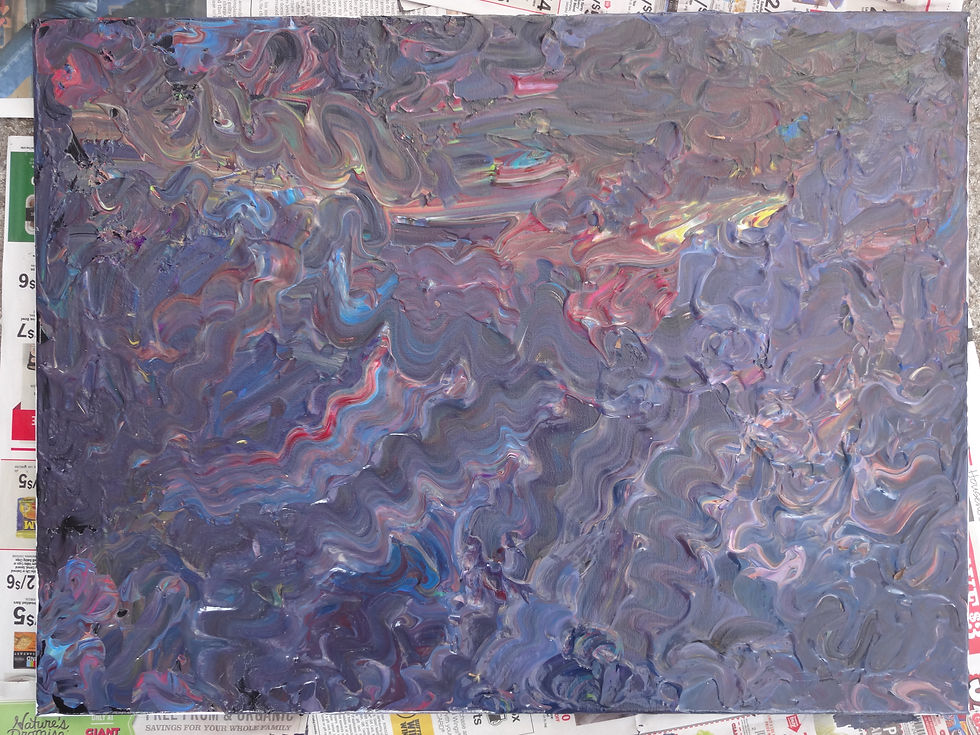Trial and (Major) Error
- Stephanie Spangler
- Mar 21, 2019
- 3 min read

Well, sometimes things work out exactly the way you planned them and other times... not so much. Art can be a lot of trial and error sometimes and this past weekend I experienced that while trying to experiment with the new fluid acrylic paints I received for Christmas.
You may have seen pictures or videos all over the internet of people making pour paintings - paintings where you literally pour a bunch of different colored paints on a canvas and move them around by tilting it until they cover the whole thing. There are a bunch of different techniques and additives you can use to get cool results so I was excited to give it a shot. I had tried doing pour paintings before with regular acrylic paints and just mixing them with a lot of water to make them easier to manipulate. The results were actually pretty good so I was excited to try again with these new paints, which presumably, would be easier to use since they were specifically designed for this kind of painting. But things didn't go as planned so here are some of the mistakes I made which you should try to avoid if you try this yourself. (Buckle up, this is about to be a long one!)
Mistake #1: Not using enough pouring medium.
Although fluid acrylics are specifically designed to be used for this type of painting, they aren't necessarily runny - at least the brand I was using wasn't. Adding pouring medium, or something called Floetrol, helps get the paint to the perfect consistency to allow it to move freely across the canvas. I did not use enough the first time so after a minute or two the paint came to a sluggish halt on the canvas and didn't really move much. And once you layer paint colors in your cup there is no way to go back and add more medium. You're stuck with what you got. Grrr...
Mistake #2: Using the wrong sized canvas.
So, while there is no set size requirement for the canvas you use for a pour painting, you should be cognizant of roughly how much paint will be required to cover it. Of course, that can be very tricky considering that you could easily go overboard and mix too much paint and have the issue of wasting it unless you have another canvas you can use with the excess. On the other hand, using too little paint means there will be large expanses of canvas that will be left untouched. It's a balancing act that takes practice to perfect. I had used a lot of paint for my first attempt, and had I used enough medium it may have just been enough to cover the canvas. But I didn't... so it just all pooled together in one corner, leaving most of the canvas empty.
Mistake #3: Trying to use a brush or other tools to move the paint around
So here's where I felt I really went off the rails. I confess that I can sometimes get impatient... okay I get impatient often. Instead of taking the time to try to let the paint on the canvas sloooooooowly make its way across more of the canvas I thought I'd try to use my finger to move some of the paint around and hopefully get it to flow in a different direction. Ugh! How I wish I hadn't done that, or at least I wish I had taken a picture of the paint as it was before I tried that. It had created a bunch of cool cells of color and all that got destroyed the moment I tried manipulating it. All my beautiful, bright colors started blending together into a muddy mess and no matter how I tried to create cool patterns and salvage it... it ultimately was just a bust. (see above) For the future, if I ever run into this issue again I will try taking the time to mix more paint - with more pouring medium - and just filling the canvas that way. Even if it turns out a mess the results can't be worse than what I ended up with!
So, despite my desire to just throw in the towel for the day I adjusted both the size of my canvases and the amount of pouring medium added to my paint and tried again. The results weren't exactly what I'd been hoping for but, (as you can see below), at least much better than the first trial. Next time I will experiment with adding either silicone or maybe even rubbing alcohol if I can find something with 70% or higher. That should create some cool cells of color and prevent too much blending.
Good luck with your own experiments! Feel free to share your success or failure stories and what you learned from each trial and error.




